|
The Woodland Education Centre |
|
|
The Woodland Education Centre |
|
Ecological Survey 2001
Spring Cut Sections (2,
4 and 7)
(Please note, the colour coding given to each section description matches that of the Belt Transect Diagram to aid understanding.) These descriptions build upon the
descriptions of the sections given in the 2000 ecological survey and should be read in
conjunction for maximum benefit. |
Section 2 - Observations 2000 - 2001
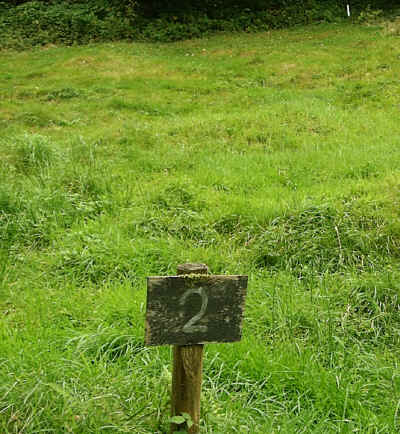 |
Section 2 continued to be a mainly grassy section, almost equally
dominated by Yorkshire Fog and Common Bent. False Oat Grass had become common in the lower half of the section. (This is the longer grass visible in the lower half of the picture on the left.) Velvet Bent had not been recorded in this section the previous year, but featured in more than a quarter of the quadrats sampled this year. Of the other spring cut sections, it also increased slightly in section 7, but remained minimal in section 4. |
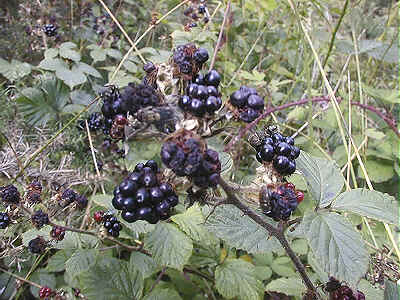 |
Bramble (left) had tripled in section 2. It had also increased, although to a much lesser extent in the other 2 spring cut sections.
|
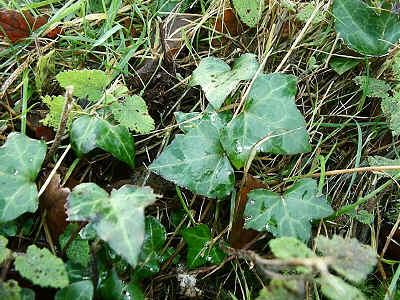 |
The amount of Ivy (left) had more than doubled in section 2. It was now a dominant species, creeping over significant patches of ground. Ivy did not feature in either of the two other spring cut sections.
|
 |
A variety of creeping herbs such as violets, Yellow Pimpernel, Heath Speedwell and Bugle were intermingled with the grasses.
|
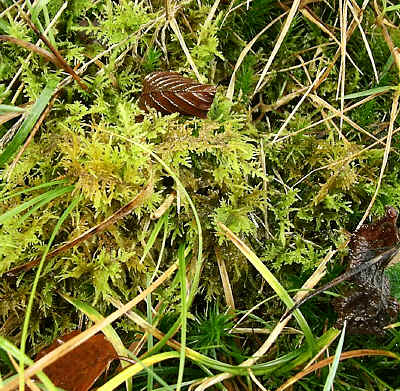 |
Although mosses were not a prominent feature of this section, Thuidium tamarascinum (left) and Eurhynchium
praelongum were abundant enough to be
dominant species. (A small sprig of Polytrichum formosum can also be seen at the bottom centre of the picture on the left.)
|
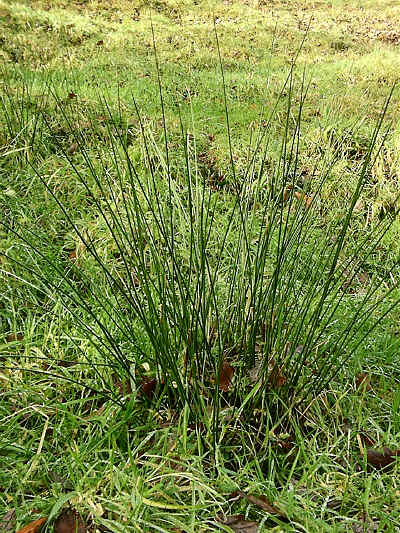 |
Compact Rush (left) which was a dominant species in section 4, was also noticeable in section 2. It was recorded in more than half the quadrats sampled in section 4, but had decreased substantially in the other spring cut section 7. Section 2 was also characterized by Enchanter's Nightshade, Hedge Woundwort and Wood Sage.
|
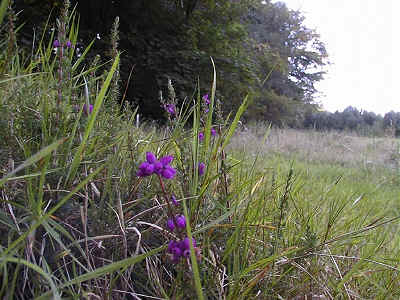 |
The patch of Bell Heather first recorded in section 2 in 1999 continued to expand.
|
Section 4 - Observations 2000 - 2001
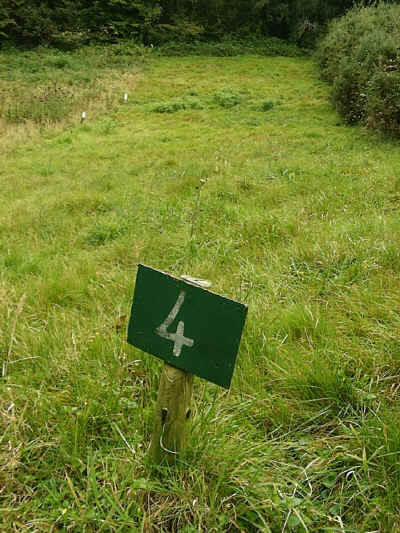 |
Section 4
was very similar to section 2. It was a grassy flower meadow, dominated by Common Bent and
Yorkshire Fog. Interspersed among the grasses in the more open areas were an abundance of ground level herbs such as violets, Yellow Pimpernel, Bugle and Greater Bird's-foot Trefoil. |
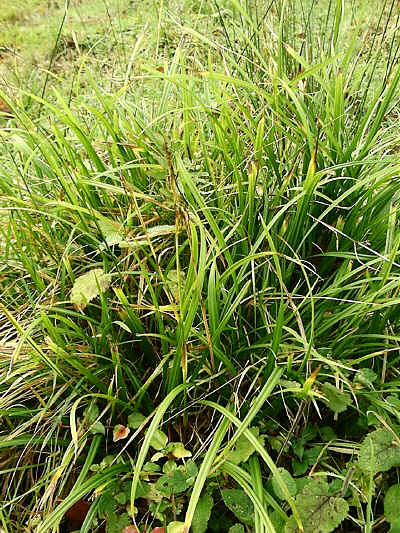 |
Section 4 also contained substantial quantities of sedges (left), especially Wood Sedge, Smooth-stalked Sedge and Glaucous Sedge. . |
 |
There were
substantial patches of Hemp-agrimony(left) in the upper half of the section. This is a
tall, perennial species characteristic of marshes, damp woods and rides and water margins. Hedge Woundwort and Raspberry were also very prominent in section 4. Moss was relatively uncommon in this section. |
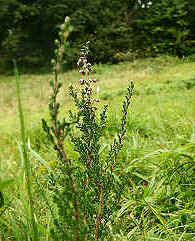 |
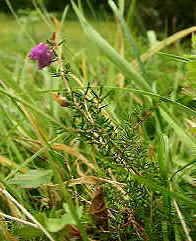 |
Heather (far left) and Bell Heather (left) continued to develop in this section. |
Section 7 -
Observations 2000 - 2001
(Spring cut plus initial grass and gorse control)
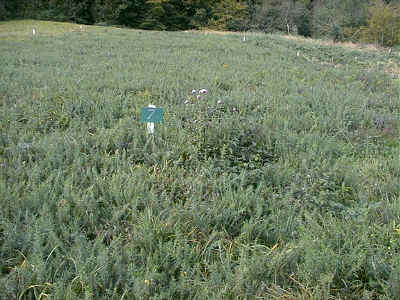 |
The lower half of section 7 continued to be very different from the rest of the spring cut sections, as well as from the neighbouring sections.
|
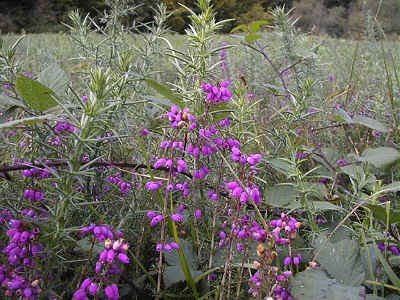 |
The bottom half was dominated by European Gorse, Heather and Bell Heather (left), with Bramble climbing amongst the other dominant plants. Where the gorse and Heather formed very thick clumps over much of the lower half of the section, there was very little moss present.
|
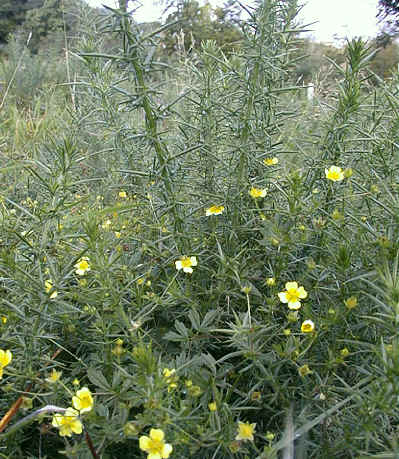 |
Mixed in among the gorse in the lower half of the section were quite
substantial quantities of Greater Bird's-foot Trefoil, Tormentil (left) and Wood Sage. Because of the patchy nature of their occurrence, the abundance of the two latter species was not truly reflected in the quadrats sampled.
|
 |
The upper half of the section was substantially different to the lower half and resembled the other spring cut sections more closely. This upper half was grassy, with Common and Velvet Bents and Yorkshire Fog as the main components. A variety of herbs, such as violet and Heath Speedwell were also interspersed among the grasses.
|
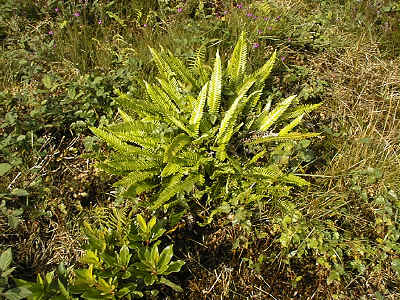 |
In amongst the grasses were Hard Fern (left) and a number of tree seedlings, particularly, birch and
cherry. Rhododendron is also visible in the lower left of the picture. |
Dominant Plants in
Spring Cut Sections in 2001
with figures from 2000 for comparison.
Characteristic heath species
are in bold print
A + sign indicates the species was present, but not recorded in the quadrats.
| Species | Section 2 | Section 4 | Section 7 | |||
| Overall % frequency (mean % cover in brackets) | 2001 | 2000 | 2001 | 2000 | 2001 | 2000 |
| Yorkshire Fog | 93 (23) | 100 (52) | 88 (45) | 96 (34) | 47 (4) | 35 (4) |
| Common Bent | 97 (44) | 88 (39) | 100 (34) | 88 (32) | 43 (15) | 74 (16) |
| Bramble | 75 (12) | 25 (2) | 71 (14) | 63 (6) | 65 (10) | 58 (8) |
| Eurhynchium praelongum | 70 (30) | 77 (28) | 25 (6) | 46 (6) | 75 (38) | 78 (29) |
| Yellow Pimpernel | 57 (12) | 27 (3) | 75 (24) | 75 (11) | 4 (0.2) | 7 (0.1) |
| Thuidium tamarascinum | 54 (20) | 45 (21) | 13 (0.5) | 9 (2) | 47 (11) | 62 (19) |
| Common Dog-violet | 47 (8) | 41 (3) | 88 (31) | 100 (21) | 32 (3) | 39 (3) |
| Wood Sage | 36 (6) | 15 (0.5) | 9 (2) | 17 (2) | + | 0 |
| Ivy | 36 (2) | 13 (1) | 0 | 0 | 0 | 0 |
| Polytrichum formosum | 32 (9) | 38 (17) | 0 | 13 (5) | 72 (33) | 65 (26) |
| Velvet Bent | 29 (4) | 0 | 4 (0.5) | 4 (4) | 39 (4) | 23 (6) |
| Hypnum jutlandicum | 29 (3) | 13 (3) | 0 | 9 (0.4) | 7 (0.5) | 13 (3) |
| Bluebell | 29 (3) | 0 | 4 (0.2) | 0 | 0 | 0 |
| European Gorse | 15 (2) | 9 (0.3) | 17 (5) | 25 (3) | 72 (40) | 72 (22) |
| Compact Rush | 15 (0.5) | 4 (0.5) | 58 (8) | 42 (3) | 15 (0.5) | 68 (4) |
| Field Woodrush | 14 (1) | 19 (1) | 0 | 9 (1) | 36 (4) | 51 (6) |
| Slender St. John's-wort | 11 (1) | 11 (0.2) | 17 (2) | 9 (0.2) | 18 (2) | 27 (2) |
| Heath Speedwell | 11 (0.5) | 7 (0.1) | 25 (5) | 17 (2) | 14 (4) | 30 (2) |
| Smooth-stalked Sedge | 7 (0.5) | 15 (3) | 25 (7) | 13 (2) | 7 (3) | 52 (15) |
| Bugle | 7 (2) | 4 (0.5) | 58 (7) | 71 (10) | 7 (2) | 0 |
| Wood Sedge | 7 (0.5) | 11 (1) | 39 (7) | 17 (2) | 18 (3) | 0 |
| Rowan | 7 (0.2) | 0 | 17 (0.5)) | 29 (2) | 7 (0.2) | 10 (0.1) |
| Raspberry | 7 (1) | 0 | 42 (6) | 29 (3) | 4 (0.2) | 4 (0.5) |
| Hedge Woundwort | 4 (1) | 4 (1) | 42 (6) | 33 (4) | 0 | 0 |
| Green-ribbed Sedge | 0 | 13 (1) | 0 | 25 (5) | 32 (9) | 7 (0.5) |
| Silver Birch | 0 | 4 (0.2) | 29 (3) | 33 (2) | 47 (6) | 45 (5) |
| Greater Bird's-foot Trefoil | 0 | 0 | 42 (10) | 50 (7) | 7 (1) | 7 (1) |
| Germander Speedwell | 0 | 0 | 38 (5) | 25 (1) | 0 | 0 |
| Heather | 0 | 0 | 0 | 4 (1) | 57 (24) | 45 (24) |
| Bell Heather | 0 | 0 | 0 | 0 | 25 (9) | 16 (6) |
| Percentage frequency = the percentage of the total number of quadrats sampled over the whole site which contain the species. For example, a percentage frequency of 100%, means that the species was found in all quadrats sampled. |
>> Continue to Autumn Cut Sections
Ecological Survey 2001 |